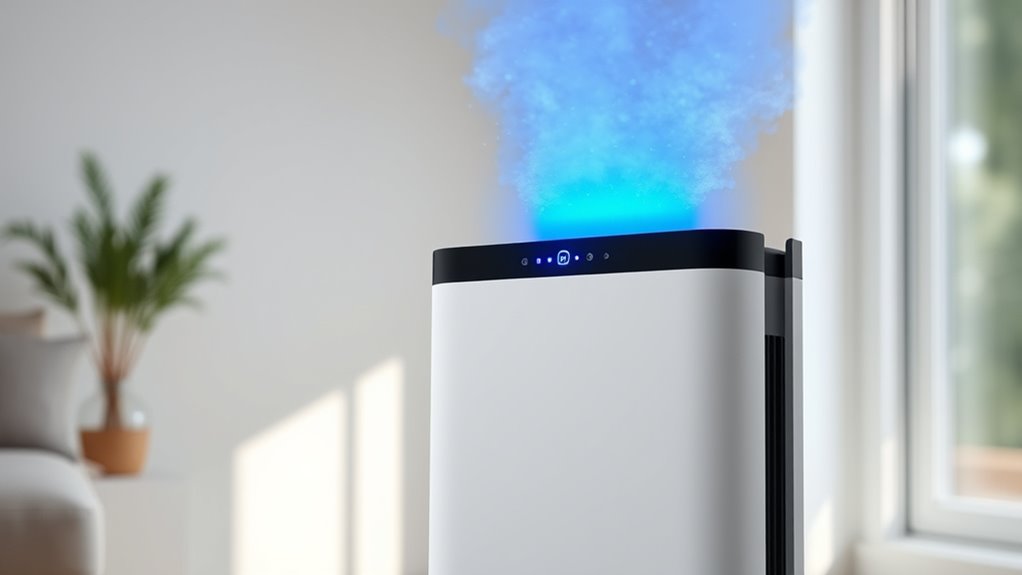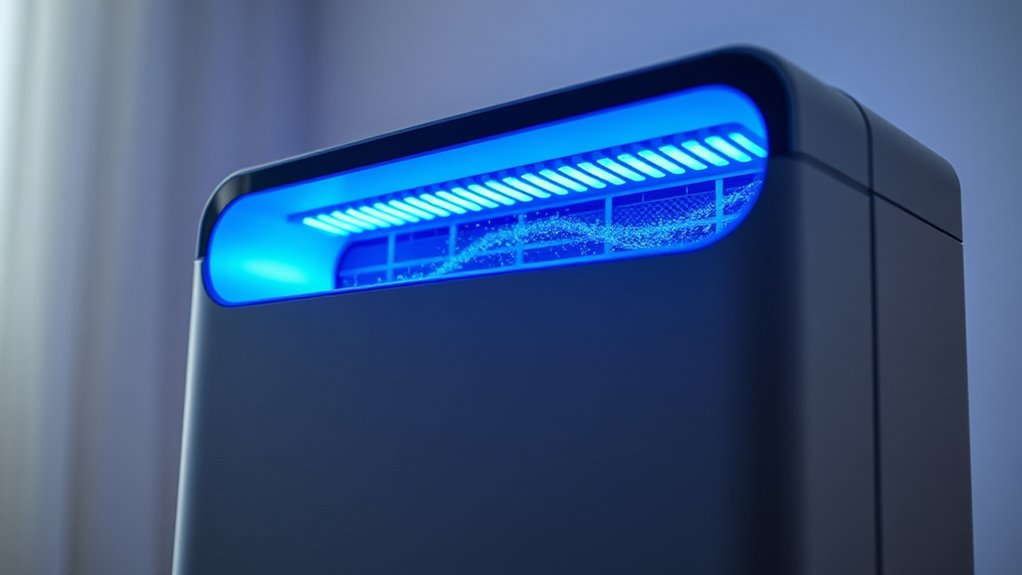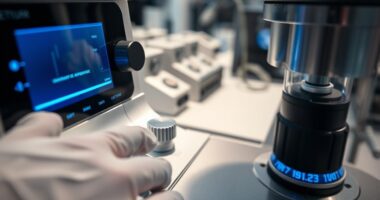UV‑C sterilization in air purifiers actively destroys airborne germs, viruses, and mold spores by disrupting their DNA or RNA. This technology provides an extra layer of protection beyond traditional filters, sterilizing pathogens in real time as air passes through the device. It reduces the risk of illness and improves indoor air quality by targeting microscopic threats. To understand how UV‑C works and its safety features, keep exploring the details behind this advanced sterilization method.
Key Takeaways
- UV-C light actively destroys airborne bacteria, viruses, and mold spores during air purification.
- It provides an extra sterilization layer beyond traditional filters, enhancing overall air quality.
- UV-C sterilization is chemical-free, safe, and environmentally friendly for indoor environments.
- It reduces the risk of airborne illness transmission by neutralizing pathogens in real time.
- Modern UV-C systems incorporate safety features and cybersecurity measures for reliable operation.

Have you ever wondered how air purifiers effectively eliminate germs and viruses? The answer largely lies in the technology they use, especially UV-C technology. UV-C, or ultraviolet C light, is a powerful tool in the fight against airborne pathogens. When incorporated into air purifiers, UV-C technology actively destroys bacteria, viruses, mold spores, and other microorganisms that can compromise your health. As air flows through the purifier, UV-C light targets these germs directly, disrupting their DNA or RNA, which prevents them from reproducing or causing infections. This process ensures that the air you breathe is not only free of visible particles but also of microscopic threats that traditional filters might miss. By integrating UV-C sterilization, air purifiers considerably boost air quality improvement, making your indoor environment safer and healthier.
The use of UV-C technology in air purifiers is a game-changer because it adds an extra layer of protection beyond standard filtration. While HEPA filters are excellent at capturing dust, pollen, and larger particles, they don’t actively kill germs. UV-C light, on the other hand, provides sterilization in real-time, reducing the risk of airborne transmission of illnesses. When air passes through the device, it’s exposed to UV-C light for a specified amount of time, ensuring thorough disinfection. This process doesn’t just improve the air’s cleanliness temporarily; it actively neutralizes pathogens, leading to sustained air quality improvement. You’ll notice a difference in how fresh and safe the air feels, especially during flu season or in areas prone to airborne illnesses.
Furthermore, UV-C sterilization is a chemical-free method, making it a safe and eco-friendly choice for your home or office. It doesn’t introduce any harmful substances into the environment or produce secondary pollutants, unlike some chemical disinfectants. As a result, you can enjoy cleaner air without worrying about chemical residues or allergic reactions. Plus, modern air purifiers with UV-C technology are designed to optimize safety; they include safeguards to prevent UV exposure to users, ensuring the sterilization process is contained within the device. Additionally, cybersecurity vulnerabilities related to electronic components in these devices are continually being addressed to protect user data and device integrity.
Frequently Asked Questions
How Long Does UV-C Sterilization Take to Purify the Air?
The air purification duration with UV-C sterilization varies, but it typically takes about 10 to 30 minutes to considerably reduce airborne microbes. Your air purifier’s sterilization efficiency depends on factors like room size and airflow rate. To guarantee effective sterilization, run the device continuously or for the recommended time, allowing enough exposure for the UV-C light to neutralize germs thoroughly and maintain clean, safe air.
Can UV-C Sterilization Damage My Air Purifier?
Think of UV-C sterilization as a vigilant guardian, not a destructive storm. It generally won’t damage your air purifier if it has good UV-C durability and is compatible with UV sterilization. Many high-quality units are designed to withstand UV exposure, ensuring longevity. Just check your device’s specifications for UV compatibility and avoid prolonged exposure, so your purifier remains a steadfast protector, not a victim of wear and tear.
Is UV-C Sterilization Safe Around Children and Pets?
UV-C sterilization can be safe around children and pets if the device is properly designed with safety features. Make certain your air purifier has automatic shut-off or shielding to prevent direct exposure to UV-C light, which can harm eyes and skin. Always follow manufacturer instructions, keep the device out of reach, and choose models specifically made with child safety and pet safety in mind. This way, you protect your loved ones while maintaining clean air.
How Often Should the UV-C Bulbs Be Replaced?
You should replace UV-C bulbs every 9 to 12 months, balancing bulb lifespan with ideal sterilization. While it might seem like a small task, neglecting timely replacements can reduce air purifier efficiency, risking contamination. Think of it as a quick upgrade that keeps your space safer. Regularly checking your device’s manual for the recommended replacement schedule ensures you get the most out of your air purifier’s UV-C sterilization.
What Maintenance Is Required for UV-C Sterilization Systems?
You should regularly inspect your UV-C sterilization system and replace the UV-C bulbs before their lifespan ends, typically every 9 to 12 months. Follow cleaning and safety protocols by turning off the device and wearing protective gear before cleaning the unit. Keep the system free of dust and debris, and handle the UV-C bulbs carefully to prevent damage and guarantee the best sterilization performance.
Conclusion
By choosing an air purifier with UV-C sterilization, you’re gently embracing a safer, healthier environment for yourself and loved ones. While it quietly works behind the scenes, it helps safeguard your space from unseen worries, offering peace of mind. Trust in this subtle yet powerful technology to nurture your well-being, creating a more comfortable, worry-free atmosphere. After all, caring for your air is a quiet act of love, making every breath a little easier.









